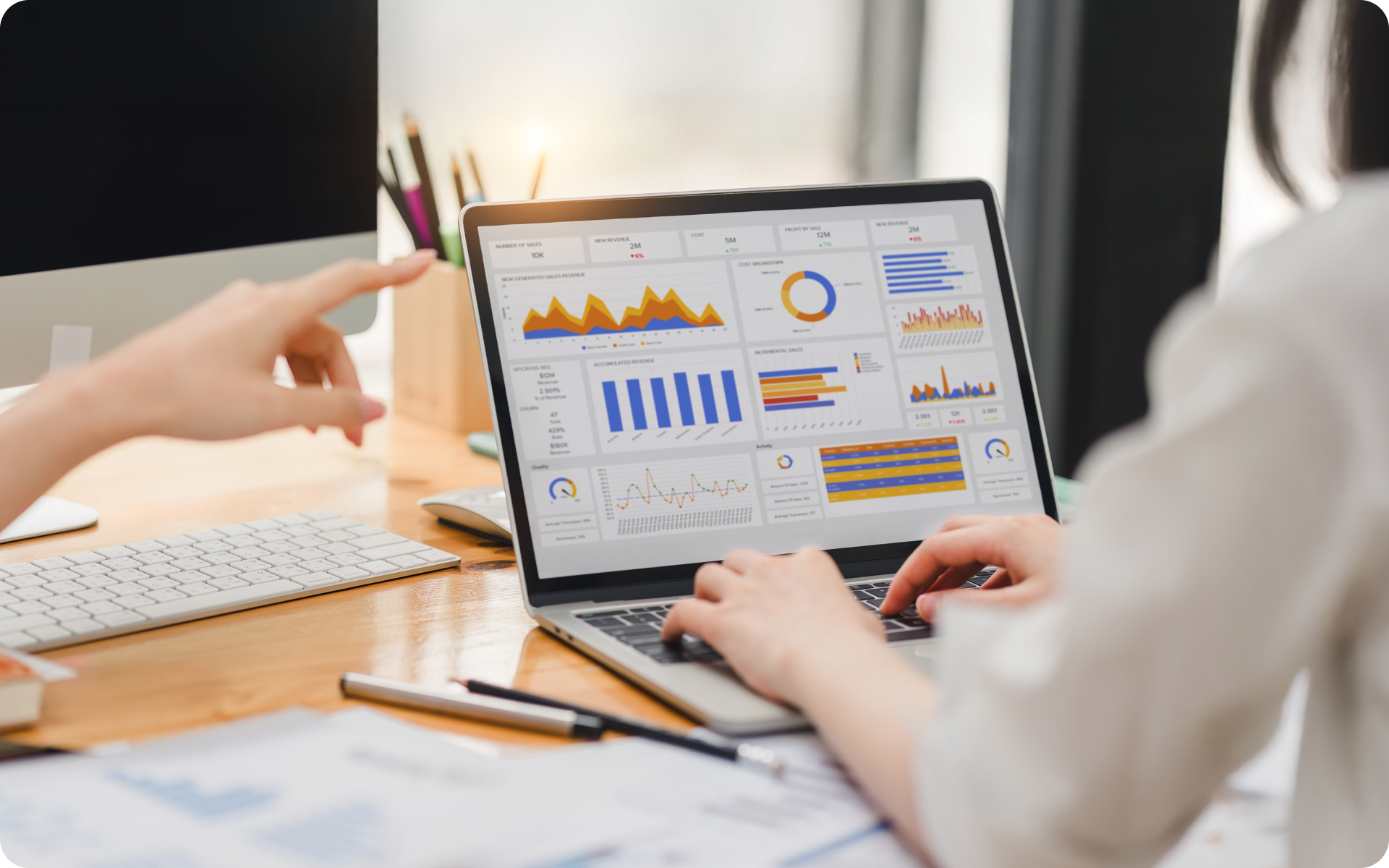Employee wellness programs have evolved from basic health screenings to comprehensive initiatives that address mental health, work-life balance, and overall employee satisfaction.
However, measuring their effectiveness has long been a challenge for human resource leaders. Traditional evaluation methods are often reliant on annual surveys, basic participation rates, and anecdotal feedback, which leaves significant gaps in understanding program impact.
Artificial Intelligence (AI) powered tools for employee wellness are changing this landscape. These sophisticated systems are able to analyze vast amounts of data in real-time, identify patterns human evaluators might miss, and provide actionable insights for program improvement (1). For C-level HR leaders, this technology represents an opportunity to move beyond guesswork and make data-driven decisions about wellness investments.
The integration of AI for health and wellness evaluation isn’t just about automation, it’s about gaining deeper insights into what truly drives employee well-being and how wellness initiatives translate into measurable business outcomes.
In this article, we explore how AI-powered tools can help drive a shift from reactive to predictive wellness management and revolutionize the ways in which organizations approach employee health.
What Makes AI-Powered Tools Effective for Wellness Programs Evaluation?
Real-Time Data Collection and Analysis
AI systems excel at processing continuous streams of data from multiple sources simultaneously. Unlike traditional evaluation methods that capture snapshots in time, AI-powered tools for employee wellness can monitor program effectiveness on an ongoing basis (2).
These systems integrate data from various touchpoints: employee engagement surveys, health screening results, benefits utilization rates, and anonymous sentiment analysis from internal communications. This comprehensive data collection provides a holistic view of program impact that manual analysis simply cannot match.
The speed of analysis is equally important. Where human evaluators may take weeks to compile and analyze quarterly wellness data, AI systems can identify trends and anomalies within hours of data collection.
Pattern Recognition Beyond Human Capability
AI algorithms can identify subtle correlations between wellness program participation and business metrics that humans might overlook (3). For example, an AI system may discover that employees who participate in mindfulness sessions show measurably improved collaboration scores in team assessments six weeks later.
This pattern recognition extends to identifying which specific program components drive the strongest outcomes. Rather than treating wellness programs as monolithic initiatives, AI can pinpoint which elements – stress management workshops, fitness challenges, or mental health resources – deliver the greatest return on investment for different employee segments.
Predictive Modeling for Proactive Intervention
Advanced AI systems don’t just analyze current data, they predict future trends and potential issues. By identifying employees at risk of burnout or disengagement before symptoms become apparent, these tools enable proactive rather than reactive wellness interventions (4, 5).
This predictive capability transforms wellness program management from damage control to prevention. HR leaders can allocate resources more effectively, targeting high-risk groups before problems escalate into costly outcomes like increased absenteeism or turnover.
Read more: 8 Employee Benefit Trends to Look out for in 2026
Which Wellness Program Metrics Can AI Track Automatically?
AI systems can automatically monitor a comprehensive range of wellness metrics, although the specific capabilities are dependent on available data sources and privacy considerations. Here are the key metrics that current AI technology can track effectively:
Participation and Engagement Metrics:
- Program enrollment rates across different employee demographics
- Session attendance patterns and completion rates
- Digital platform usage analytics for wellness apps and resources
- Engagement depth measurements (time spent, content consumed)
Health Outcome Indicators:
- Biometric screening trends when aggregated and anonymized
- Health risk assessment score changes over time
- Preventive care utilization rates
- Sick leave patterns and duration trends
BetterMe provides members with tailored plans that are based on their unique physical, psychological, and lifestyle needs and health goals. Start using BetterMe corporate wellness solutions to transform your team and business!
Behavioral and Performance Correlations:
- Productivity metrics correlated with wellness program participation
- Employee satisfaction survey responses relating to well-being initiatives
- Retention rates among program participants versus non-participants
- Absenteeism patterns and their relationship to wellness engagement
Mental Health and Stress Indicators:
- Anonymous sentiment analysis from employee communications
- Stress level indicators from voluntary wearable device data
- Work-life balance survey responses and trends
- Help-seeking behavior patterns for mental health resources
Financial and ROI Metrics:
- Healthcare cost trends among program participants
- Workers’ compensation claim patterns
- Disability claim rates and duration
- Overall program cost-effectiveness calculations
It’s important to note that all health-related data tracking must comply with privacy regulations such as the Health Insurance Portability and Accountability Act (HIPAA) and that it requires explicit employee consent (6, 7). AI systems should only access aggregated, anonymized data to protect individual privacy while still providing meaningful insights.
How Accurate Are AI-Generated Insights for Wellness Programs?
The accuracy of AI-generated insights for wellness programs is heavily dependent on data quality, algorithm sophistication, and implementation methodology. Current research suggests that well-implemented AI systems can achieve high accuracy rates, but several factors influence their reliability (8).
- Data Quality as the Foundation
AI systems are only as accurate as the data they analyze. High-quality, comprehensive datasets produce more reliable insights than sparse or inconsistent information. Organizations with robust data collection processes, including regular employee surveys, consistent health screenings, and integrated HR systems, typically see better AI accuracy rates.
Incomplete or biased data can lead to misleading insights. For example, if only health-conscious employees participate in biometric screenings, AI analysis may overestimate program effectiveness across the entire workforce.
- Algorithm Limitations and Strengths
Modern AI algorithms excel at identifying statistical correlations but may struggle with causation (9). An AI system may correctly identify that employees who use the company gym have lower stress scores, but it cannot definitively prove that gym usage causes reduced stress – other factors may explain both behaviors.
However, AI systems consistently outperform traditional analysis methods in identifying complex, multi-variable relationships. Research has indicated that AI can detect wellness program effectiveness patterns that human analysts miss, particularly when multiple factors interact simultaneously (10).
- Validation Through Cross-Referencing
The most accurate AI implementations use multiple data validation methods. This includes comparing AI predictions against known outcomes, cross-referencing insights with traditional evaluation methods, and conducting periodic accuracy audits.
Organizations should expect AI accuracy to improve over time as systems learn from more data and feedback (11). Initial implementations may show 70-80% accuracy rates, improving to 85-90% as the system refines its algorithms based on organizational-specific patterns.
For comprehensive guidance on building effective employee wellness initiatives that can benefit from AI evaluation, explore our detailed workplace wellness program implementation guide.
Can Existing HR Systems Integrate with AI-Powered Tools?
Most modern HR information systems (HRIS) can integrate with AI-powered wellness evaluation tools, although the complexity and cost of integration vary significantly based on system architecture and vendor capabilities (12).
- API-Based Integration Possibilities
Contemporary HRIS platforms typically offer Application Programming Interfaces (APIs) that allow third-party AI tools to access relevant data. Popular systems such as Workday, BambooHR, and ADP provide integration capabilities that enable AI tools to pull employee demographic data, participation records, and survey responses (13).
The integration process usually involves mapping data fields between systems, establishing secure data transfer protocols, and setting up automated synchronization schedules. Most organizations can complete basic integrations within 30-60 days with proper technical support.
- Legacy System Challenges
Older HR systems may require more extensive modification or middleware solutions to enable AI integration. Organizations that use legacy systems may need to invest in system upgrades or data extraction tools to make integration feasible.
Custom-built HR systems present unique challenges as they lack standardized integration protocols. These situations often require specialized development work to create connection points for AI tools.
- Data Security and Compliance Considerations
Integration must maintain strict data security standards, particularly when handling sensitive health information. Most enterprise-grade AI wellness tools offer security features that include end-to-end encryption, role-based access controls, and audit trail capabilities.
Organizations should verify that AI vendors meet relevant compliance standards (HIPAA, GDPR, SOC 2) before they begin integration projects. The integration architecture should include safeguards that prevent unauthorized access while enabling necessary data flow for analysis.
- Vendor Ecosystem Compatibility
Many HRIS vendors now partner with AI wellness solution providers to offer pre-built integrations. These partnerships often result in smoother implementation processes and ongoing technical support. Organizations should investigate whether their current HRIS vendor offers recommended AI wellness partners.
Cloud-based HR systems generally offer more flexible integration options than on-premises solutions. The scalability and update frequency of cloud platforms make them better suited for AI tool integration (14).
Read more: The Quiet Cost of Neglected Well-Being in BPO Teams and What to Do About It
How Frequently Should AI Update Wellness Program Analytics?
The optimal frequency for AI analytics updates is dependent on organizational needs, data types, and decision-making cycles. Most successful implementations use a tiered approach with different update frequencies for various types of analysis (15).
Real-Time Monitoring for Critical Metrics
Certain wellness metrics benefit from continuous monitoring. Employee safety indicators, crisis mental health signals, and participation in time-sensitive programs should be updated in real-time or near real-time.
This continuous monitoring enables immediate intervention when needed. For example, AI systems can flag sudden drops in employee engagement scores that may indicate emerging workplace stressors requiring prompt attention.
Daily Updates for Operational Metrics
Program participation rates, resource utilization, and basic engagement metrics typically update daily. This frequency provides sufficient granularity for operational management without overwhelming HR teams with constant notifications.
Daily updates allow HR leaders to make timely adjustments to program delivery, resource allocation, and communication strategies based on participation trends and engagement patterns.
Weekly Analysis for Trend Identification
Behavioral patterns, correlation analysis, and predictive modeling perform best with weekly update cycles. This timeframe provides enough data points to identify meaningful trends while maintaining analytical relevance.
Weekly reports can highlight emerging patterns in employee well-being, program effectiveness across different demographics, and early warning indicators for potential issues.
Monthly Comprehensive Reviews
Strategic insights, ROI calculations, and long-term trend analysis benefit from monthly comprehensive updates. These reports provide the depth needed for budget planning, program modifications, and stakeholder reporting.
Monthly analysis cycles align well with typical HR reporting schedules and provide sufficient time for implementing recommended changes based on AI insights.
Quarterly Deep-Dive Evaluations
Comprehensive program effectiveness evaluations, predictive modeling updates, and strategic planning insights work best on quarterly cycles. This frequency allows for meaningful data accumulation while providing timely input for annual planning processes.
Quarterly evaluations can assess seasonal variations in wellness program effectiveness and provide insights for long-term strategic adjustments.
For more comprehensive strategies on maintaining employee engagement year-round, explore our guide on wellness tips for employees.
How to Validate AI Recommendations Against Human Expertise
Balancing AI insights with human judgment is essential for effective wellness program management. While AI excels at data analysis, human expertise provides context, ethical considerations, and a nuanced understanding that algorithms are unable to replicate.
Establishing Cross-Validation Protocols
Effective validation requires structured processes that systematically compare AI recommendations against expert analysis. Organizations should establish review panels that include HR professionals, wellness program managers, and healthcare experts who can evaluate AI insights from a variety of different perspectives.
These panels should meet regularly to review AI recommendations, assess their practical feasibility, and identify potential blind spots in algorithmic analysis. The goal is not to override AI insights but to ensure they are aligned with organizational values and employee needs.
Documentation of validation decisions creates valuable feedback loops that improve both AI accuracy and human understanding of system capabilities over time.
Are you looking to transform both your business and the lives of your team members? BetterMe corporate wellness solutions provide a holistic approach to physical and mental health that boosts productivity and job satisfaction.
Creating Feedback Loops for Continuous Improvement
AI systems improve through exposure to expert feedback on their recommendations. Organizations should implement structured feedback mechanisms that capture when human experts agree or disagree with AI suggestions and the reasoning behind these decisions.
This feedback helps AI systems learn organizational-specific patterns and preferences that generic algorithms may miss. These feedback loops reduce the frequency of recommendations that require human override over time.
Regular calibration sessions between AI systems and human experts ensure both parties understand their respective strengths and limitations in wellness program evaluation.
Implementing Staged Decision-Making Processes
Complex wellness program decisions benefit from staged implementation that combines AI insights with human oversight. This approach may involve AI systems identifying potential issues or opportunities, human experts evaluating the recommendations, and collaborative development of implementation strategies.
For example, if AI identifies declining participation in mental health resources among remote employees, human experts can evaluate potential causes, cultural factors, and appropriate intervention strategies before implementing changes.
This staged approach maximizes the analytical power of AI while preserving the contextual understanding and ethical judgment that human experts provide.
Maintaining Human-Centric Focus
AI validation processes must keep employee well-being as the primary objective. Technical accuracy of AI recommendations matters less than their practical impact on employee health and satisfaction.
Human experts should evaluate AI recommendations for statistical validity and their alignment with organizational culture, employee preferences, and ethical considerations that algorithms cannot assess.
Regular employee feedback on AI-recommended program changes provides a further validation layer that ensures technological capabilities serve human needs rather than driving them.
Understanding seasonal variations in employee wellness needs can enhance validation accuracy. Learn more about adapting programs throughout the year in our summer wellness tips resource.
The Bottom Line
AI-powered tools represent a significant advancement in wellness program evaluation capabilities, but their success depends on thoughtful implementation and realistic expectations. These systems excel at identifying patterns, predicting trends, and processing vast amounts of data that would overwhelm human analysts.
However, the most effective implementations combine AI capabilities with human expertise, leading to the creation of evaluation systems that are both analytically powerful and contextually appropriate. Organizations should view AI as an enhancement to human judgment rather than a replacement for it.
The accuracy and value of AI insights improve over time as systems learn from organizational data and expert feedback. Early implementations may require more human oversight, but this investment typically pays dividends through increasingly sophisticated and relevant recommendations.
For HR leaders who are considering AI integration, the key is to start with clear objectives, ensure data quality, and maintain focus on employee outcomes rather than technological sophistication. The goal is better wellness programs that truly serve employee needs, not impressive technology for its own sake.
As AI capabilities continue to advance, organizations that establish strong foundations now will be better positioned to leverage future innovations. The intersection of AI for mental health, predictive analytics, and personalized wellness programming promises even more sophisticated evaluation capabilities in the coming years.
DISCLAIMER:
This article is intended for general informational purposes only and does not serve to address individual circumstances. It is not a substitute for professional advice or help and should not be relied on for making any kind of decision-making. Any action taken as a direct or indirect result of the information in this article is entirely at your own risk and is your sole responsibility.
BetterMe, its content staff, and its medical advisors accept no responsibility for inaccuracies, errors, misstatements, inconsistencies, or omissions and specifically disclaim any liability, loss or risk, personal, professional or otherwise, which may be incurred as a consequence, directly or indirectly, of the use and/or application of any content.
You should always seek the advice of your physician or other qualified health provider with any questions you may have regarding a medical condition or your specific situation. Never disregard professional medical advice or delay seeking it because of BetterMe content. If you suspect or think you may have a medical emergency, call your doctor.
SOURCES:
- Insights from the Job Demands–Resources Model: AI’s dual impact on employees’ work and life well-being (2021, sciencedirect.com)
- Artificial Intelligence in Human Resource Management AI-Based Employee Wellness Programs: Enhancing Wellbeing and Productivity (2024, researchgate.net)
- The Predictive Analytics for Employee Wellness And An AI-Driven Solution to Minimize Workplace Burnout (2024, researchgate.net)
- AI-Powered Predictive Models for Identifying and Mitigating Burnout Risks in IT Professionals (2024, researchgate.net)
- Balancing act: the complex role of artificial intelligence in addressing burnout and healthcare workforce dynamics (2024, pmc.ncbi.nlm.nih.gov)
- Ensuring Data Privacy and Security in AI-Driven Healthcare Systems (2025, researchgate.net)
- AI AND EMPLOYEE WELLBEING: HOW ARTIFICIAL INTELLIGENCE CAN MONITOR AND IMPROVE MENTAL HEALTH IN THE WORKPLACE (2024, researchgate.net)
- Assessing the Reliability of Artificial Intelligence Systems: Challenges, Metrics, and Future Directions (2024, researchgate.net)
- Confusing Correlation with Causation (2023, mindmatters.ai)
- AI and employee wellbeing in the workplace: An empirical study (2025, sciencedirect.com)
- Data Accuracy Critical to Success: Leveraging Artificial Intelligence for Business Growth (2021, v500.com)
- Intelligent human resource information system (i-HRIS): A holistic decision support framework for HR excellence (2018, researchgate.net)
- HRIS (Human Resource Information System): Meaning, Software, Examples (2024, hipeople.io)
- Cloud-Based Human Resources Solutions: Streamlining Employee Management (2019, researchgate.net)
- Reviewing employee well-being and mental health initiatives in contemporary HR Practices (2024, researchgate.net)













